IT Ethics Case Study: Analyzing the Dilemma of Willy's Project
VerifiedAdded on 2021/04/21
|6
|1474
|250
Case Study
AI Summary
This case study examines an ethical dilemma within a software development company concerning Willy's project. The project director wants to deliver the project early to secure a new contract, but this requires omitting crucial encryption steps, raising significant data security concerns. The analysis explores the facts, issues, and stakeholders affected, including the company, client, and customers. The ethical issues revolve around compromising customer data and the project manager's potential conflict of interest. The implications of the decision include potential data breaches, reputational damage, and financial losses. The study considers various options, concluding that the best approach involves prioritizing data security by communicating the risks to the program director. The solution emphasizes the importance of adhering to organizational objectives and protecting the brand reputation of the company. The case study provides a comprehensive analysis of the ethical considerations and offers potential solutions for navigating the dilemma.

Running head: TOPICS IN IT ETHICS
Topics in IT Ethics
Name of the Student
Name of the University
Author Note
Topics in IT Ethics
Name of the Student
Name of the University
Author Note
Paraphrase This Document
Need a fresh take? Get an instant paraphrase of this document with our AI Paraphraser
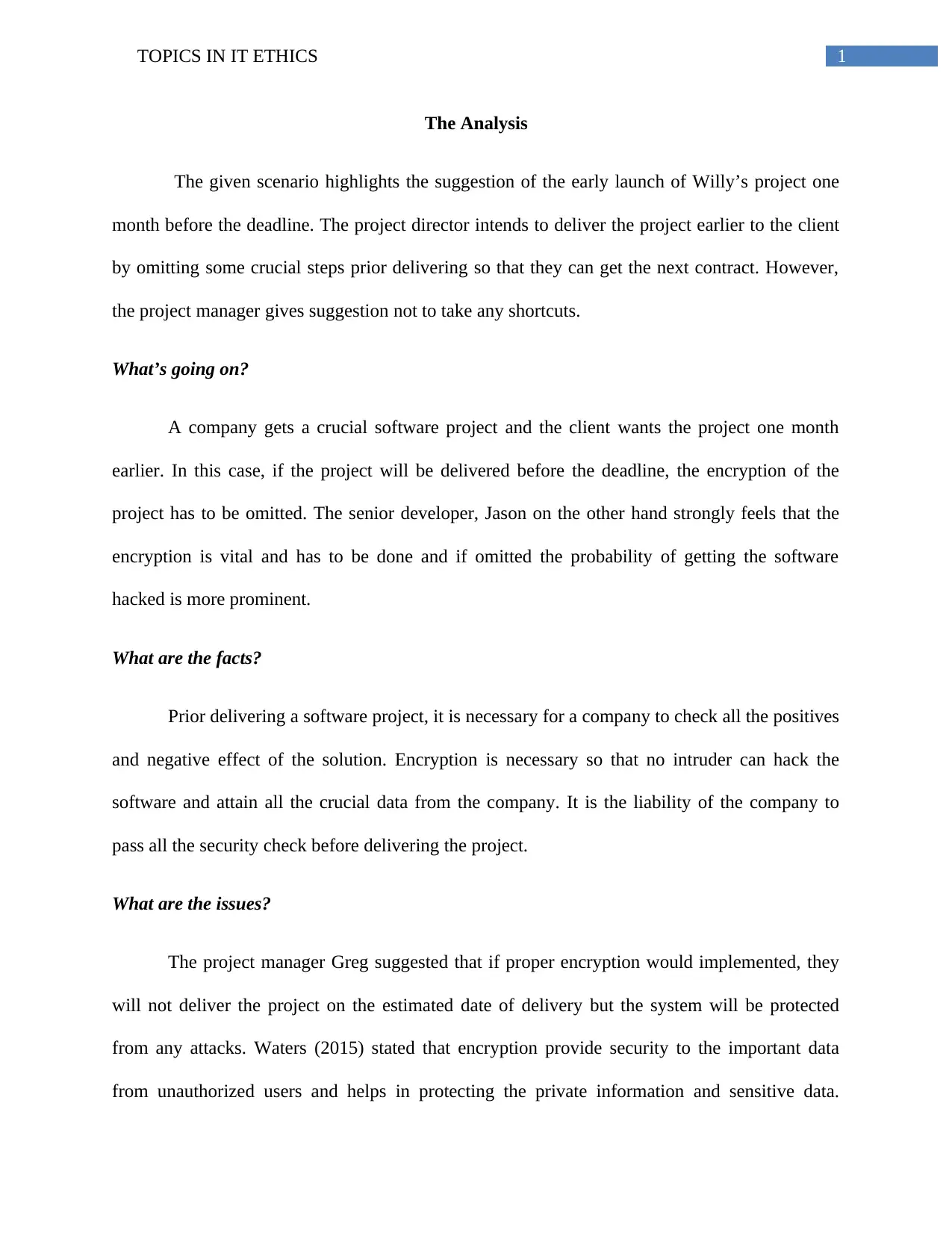
1TOPICS IN IT ETHICS
The Analysis
The given scenario highlights the suggestion of the early launch of Willy’s project one
month before the deadline. The project director intends to deliver the project earlier to the client
by omitting some crucial steps prior delivering so that they can get the next contract. However,
the project manager gives suggestion not to take any shortcuts.
What’s going on?
A company gets a crucial software project and the client wants the project one month
earlier. In this case, if the project will be delivered before the deadline, the encryption of the
project has to be omitted. The senior developer, Jason on the other hand strongly feels that the
encryption is vital and has to be done and if omitted the probability of getting the software
hacked is more prominent.
What are the facts?
Prior delivering a software project, it is necessary for a company to check all the positives
and negative effect of the solution. Encryption is necessary so that no intruder can hack the
software and attain all the crucial data from the company. It is the liability of the company to
pass all the security check before delivering the project.
What are the issues?
The project manager Greg suggested that if proper encryption would implemented, they
will not deliver the project on the estimated date of delivery but the system will be protected
from any attacks. Waters (2015) stated that encryption provide security to the important data
from unauthorized users and helps in protecting the private information and sensitive data.
The Analysis
The given scenario highlights the suggestion of the early launch of Willy’s project one
month before the deadline. The project director intends to deliver the project earlier to the client
by omitting some crucial steps prior delivering so that they can get the next contract. However,
the project manager gives suggestion not to take any shortcuts.
What’s going on?
A company gets a crucial software project and the client wants the project one month
earlier. In this case, if the project will be delivered before the deadline, the encryption of the
project has to be omitted. The senior developer, Jason on the other hand strongly feels that the
encryption is vital and has to be done and if omitted the probability of getting the software
hacked is more prominent.
What are the facts?
Prior delivering a software project, it is necessary for a company to check all the positives
and negative effect of the solution. Encryption is necessary so that no intruder can hack the
software and attain all the crucial data from the company. It is the liability of the company to
pass all the security check before delivering the project.
What are the issues?
The project manager Greg suggested that if proper encryption would implemented, they
will not deliver the project on the estimated date of delivery but the system will be protected
from any attacks. Waters (2015) stated that encryption provide security to the important data
from unauthorized users and helps in protecting the private information and sensitive data.
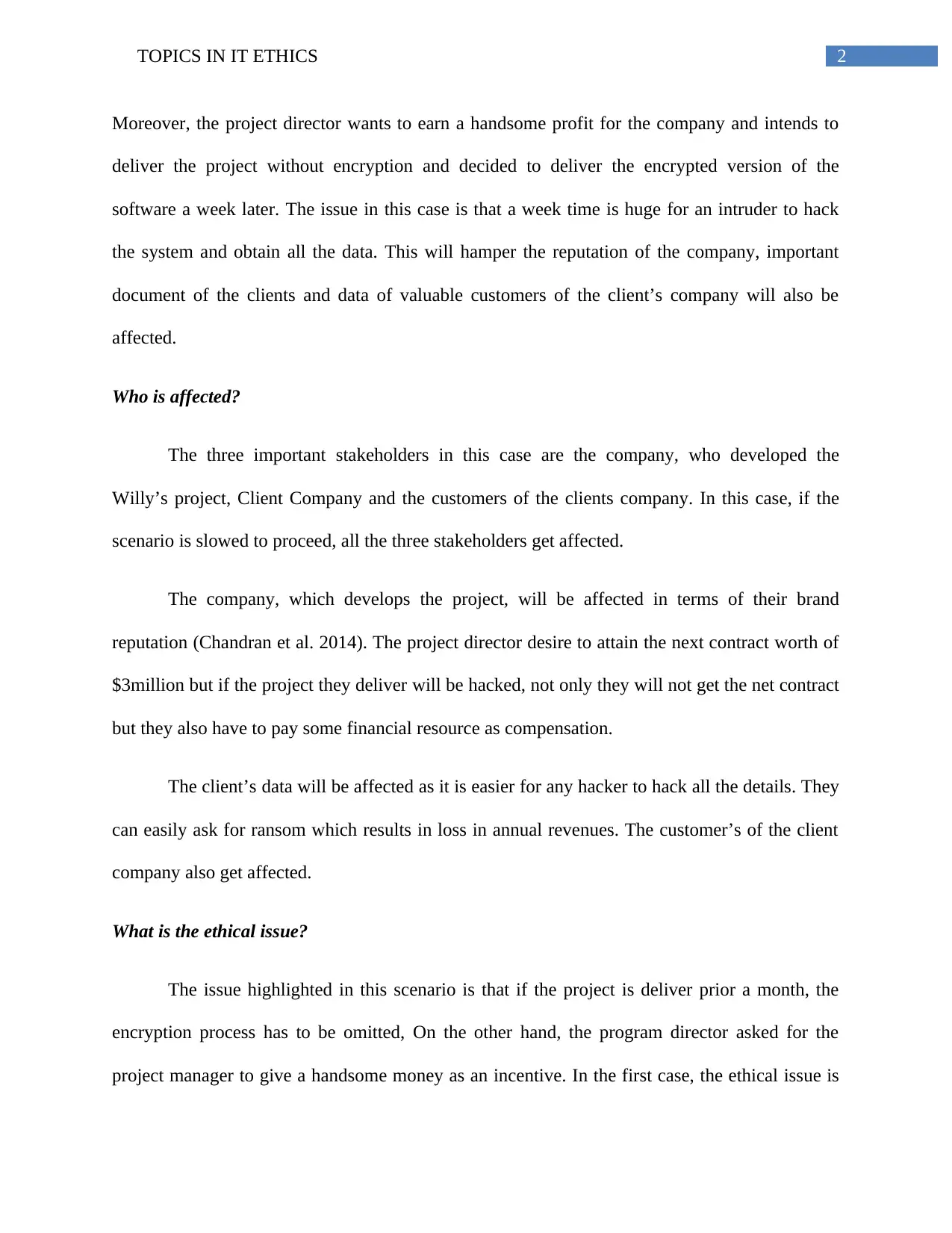
2TOPICS IN IT ETHICS
Moreover, the project director wants to earn a handsome profit for the company and intends to
deliver the project without encryption and decided to deliver the encrypted version of the
software a week later. The issue in this case is that a week time is huge for an intruder to hack
the system and obtain all the data. This will hamper the reputation of the company, important
document of the clients and data of valuable customers of the client’s company will also be
affected.
Who is affected?
The three important stakeholders in this case are the company, who developed the
Willy’s project, Client Company and the customers of the clients company. In this case, if the
scenario is slowed to proceed, all the three stakeholders get affected.
The company, which develops the project, will be affected in terms of their brand
reputation (Chandran et al. 2014). The project director desire to attain the next contract worth of
$3million but if the project they deliver will be hacked, not only they will not get the net contract
but they also have to pay some financial resource as compensation.
The client’s data will be affected as it is easier for any hacker to hack all the details. They
can easily ask for ransom which results in loss in annual revenues. The customer’s of the client
company also get affected.
What is the ethical issue?
The issue highlighted in this scenario is that if the project is deliver prior a month, the
encryption process has to be omitted, On the other hand, the program director asked for the
project manager to give a handsome money as an incentive. In the first case, the ethical issue is
Moreover, the project director wants to earn a handsome profit for the company and intends to
deliver the project without encryption and decided to deliver the encrypted version of the
software a week later. The issue in this case is that a week time is huge for an intruder to hack
the system and obtain all the data. This will hamper the reputation of the company, important
document of the clients and data of valuable customers of the client’s company will also be
affected.
Who is affected?
The three important stakeholders in this case are the company, who developed the
Willy’s project, Client Company and the customers of the clients company. In this case, if the
scenario is slowed to proceed, all the three stakeholders get affected.
The company, which develops the project, will be affected in terms of their brand
reputation (Chandran et al. 2014). The project director desire to attain the next contract worth of
$3million but if the project they deliver will be hacked, not only they will not get the net contract
but they also have to pay some financial resource as compensation.
The client’s data will be affected as it is easier for any hacker to hack all the details. They
can easily ask for ransom which results in loss in annual revenues. The customer’s of the client
company also get affected.
What is the ethical issue?
The issue highlighted in this scenario is that if the project is deliver prior a month, the
encryption process has to be omitted, On the other hand, the program director asked for the
project manager to give a handsome money as an incentive. In the first case, the ethical issue is
⊘ This is a preview!⊘
Do you want full access?
Subscribe today to unlock all pages.

Trusted by 1+ million students worldwide
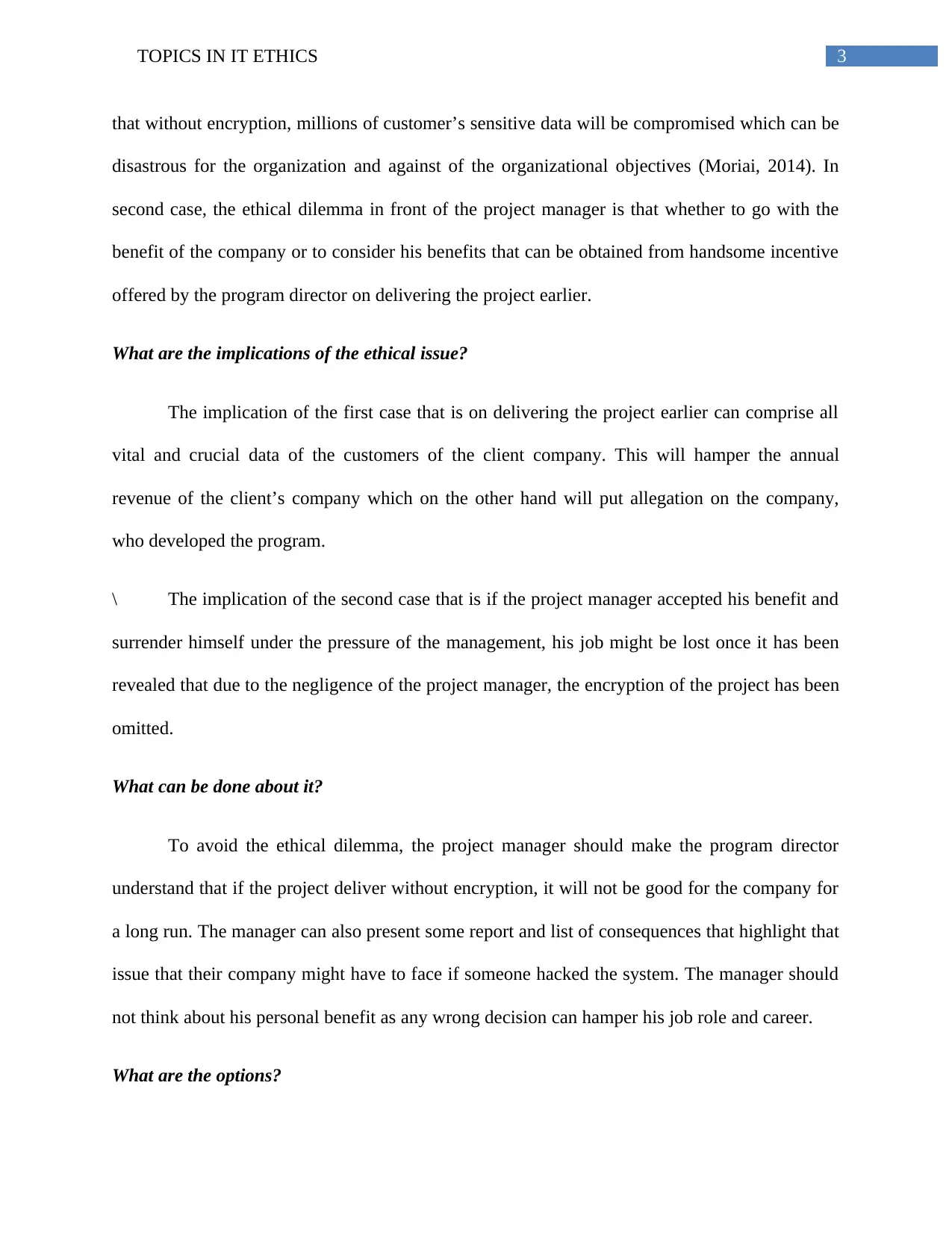
3TOPICS IN IT ETHICS
that without encryption, millions of customer’s sensitive data will be compromised which can be
disastrous for the organization and against of the organizational objectives (Moriai, 2014). In
second case, the ethical dilemma in front of the project manager is that whether to go with the
benefit of the company or to consider his benefits that can be obtained from handsome incentive
offered by the program director on delivering the project earlier.
What are the implications of the ethical issue?
The implication of the first case that is on delivering the project earlier can comprise all
vital and crucial data of the customers of the client company. This will hamper the annual
revenue of the client’s company which on the other hand will put allegation on the company,
who developed the program.
\ The implication of the second case that is if the project manager accepted his benefit and
surrender himself under the pressure of the management, his job might be lost once it has been
revealed that due to the negligence of the project manager, the encryption of the project has been
omitted.
What can be done about it?
To avoid the ethical dilemma, the project manager should make the program director
understand that if the project deliver without encryption, it will not be good for the company for
a long run. The manager can also present some report and list of consequences that highlight that
issue that their company might have to face if someone hacked the system. The manager should
not think about his personal benefit as any wrong decision can hamper his job role and career.
What are the options?
that without encryption, millions of customer’s sensitive data will be compromised which can be
disastrous for the organization and against of the organizational objectives (Moriai, 2014). In
second case, the ethical dilemma in front of the project manager is that whether to go with the
benefit of the company or to consider his benefits that can be obtained from handsome incentive
offered by the program director on delivering the project earlier.
What are the implications of the ethical issue?
The implication of the first case that is on delivering the project earlier can comprise all
vital and crucial data of the customers of the client company. This will hamper the annual
revenue of the client’s company which on the other hand will put allegation on the company,
who developed the program.
\ The implication of the second case that is if the project manager accepted his benefit and
surrender himself under the pressure of the management, his job might be lost once it has been
revealed that due to the negligence of the project manager, the encryption of the project has been
omitted.
What can be done about it?
To avoid the ethical dilemma, the project manager should make the program director
understand that if the project deliver without encryption, it will not be good for the company for
a long run. The manager can also present some report and list of consequences that highlight that
issue that their company might have to face if someone hacked the system. The manager should
not think about his personal benefit as any wrong decision can hamper his job role and career.
What are the options?
Paraphrase This Document
Need a fresh take? Get an instant paraphrase of this document with our AI Paraphraser
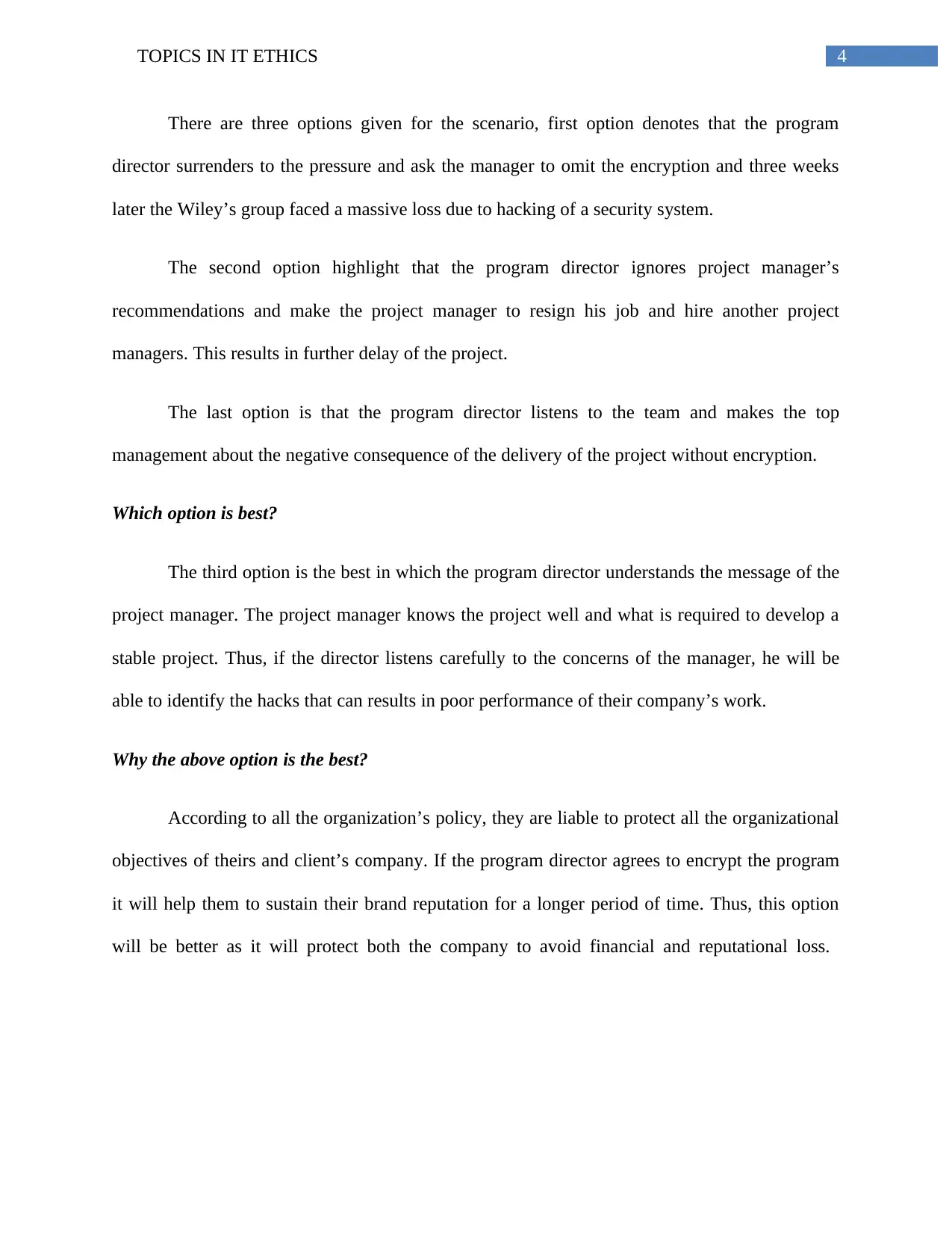
4TOPICS IN IT ETHICS
There are three options given for the scenario, first option denotes that the program
director surrenders to the pressure and ask the manager to omit the encryption and three weeks
later the Wiley’s group faced a massive loss due to hacking of a security system.
The second option highlight that the program director ignores project manager’s
recommendations and make the project manager to resign his job and hire another project
managers. This results in further delay of the project.
The last option is that the program director listens to the team and makes the top
management about the negative consequence of the delivery of the project without encryption.
Which option is best?
The third option is the best in which the program director understands the message of the
project manager. The project manager knows the project well and what is required to develop a
stable project. Thus, if the director listens carefully to the concerns of the manager, he will be
able to identify the hacks that can results in poor performance of their company’s work.
Why the above option is the best?
According to all the organization’s policy, they are liable to protect all the organizational
objectives of theirs and client’s company. If the program director agrees to encrypt the program
it will help them to sustain their brand reputation for a longer period of time. Thus, this option
will be better as it will protect both the company to avoid financial and reputational loss.
There are three options given for the scenario, first option denotes that the program
director surrenders to the pressure and ask the manager to omit the encryption and three weeks
later the Wiley’s group faced a massive loss due to hacking of a security system.
The second option highlight that the program director ignores project manager’s
recommendations and make the project manager to resign his job and hire another project
managers. This results in further delay of the project.
The last option is that the program director listens to the team and makes the top
management about the negative consequence of the delivery of the project without encryption.
Which option is best?
The third option is the best in which the program director understands the message of the
project manager. The project manager knows the project well and what is required to develop a
stable project. Thus, if the director listens carefully to the concerns of the manager, he will be
able to identify the hacks that can results in poor performance of their company’s work.
Why the above option is the best?
According to all the organization’s policy, they are liable to protect all the organizational
objectives of theirs and client’s company. If the program director agrees to encrypt the program
it will help them to sustain their brand reputation for a longer period of time. Thus, this option
will be better as it will protect both the company to avoid financial and reputational loss.
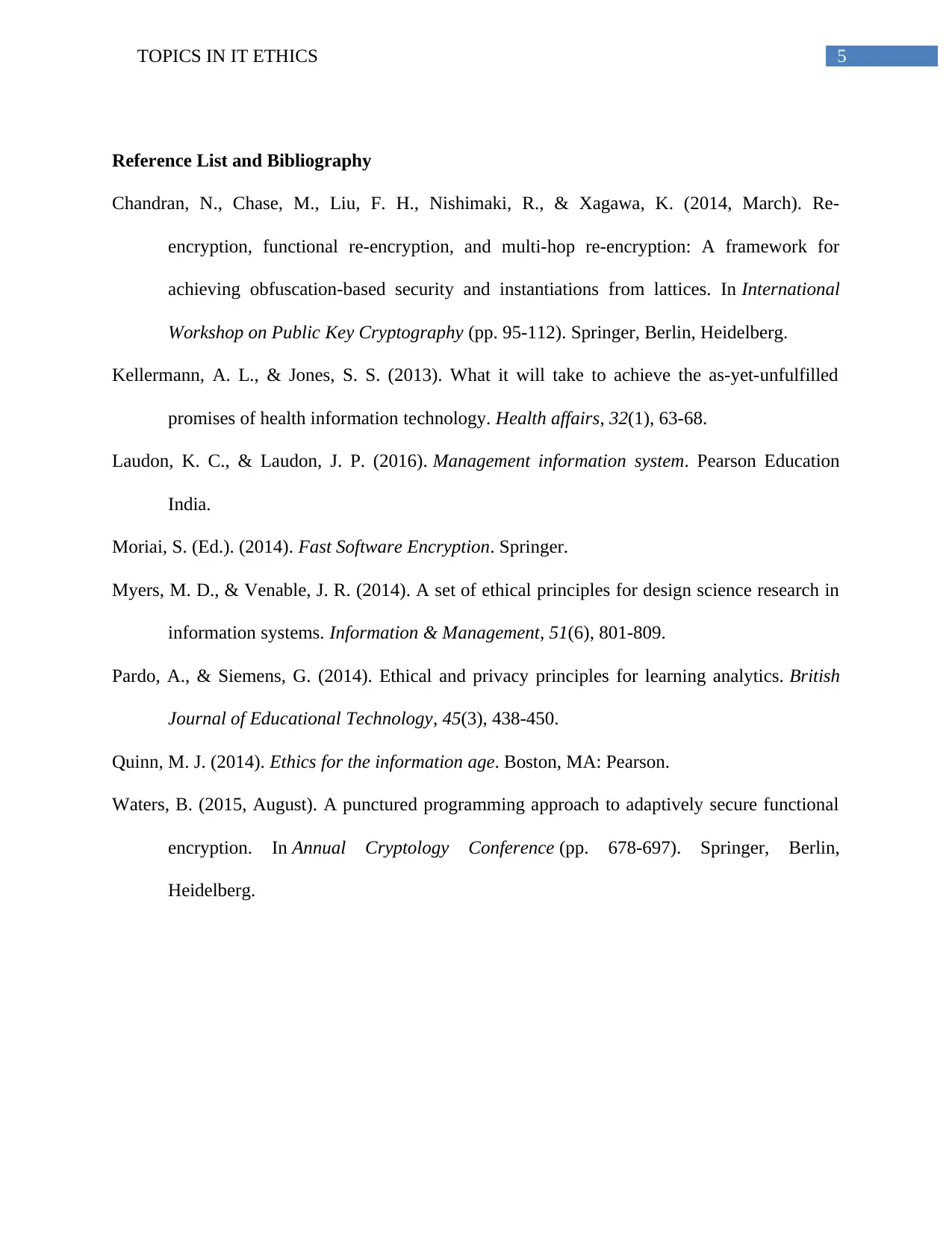
5TOPICS IN IT ETHICS
Reference List and Bibliography
Chandran, N., Chase, M., Liu, F. H., Nishimaki, R., & Xagawa, K. (2014, March). Re-
encryption, functional re-encryption, and multi-hop re-encryption: A framework for
achieving obfuscation-based security and instantiations from lattices. In International
Workshop on Public Key Cryptography (pp. 95-112). Springer, Berlin, Heidelberg.
Kellermann, A. L., & Jones, S. S. (2013). What it will take to achieve the as-yet-unfulfilled
promises of health information technology. Health affairs, 32(1), 63-68.
Laudon, K. C., & Laudon, J. P. (2016). Management information system. Pearson Education
India.
Moriai, S. (Ed.). (2014). Fast Software Encryption. Springer.
Myers, M. D., & Venable, J. R. (2014). A set of ethical principles for design science research in
information systems. Information & Management, 51(6), 801-809.
Pardo, A., & Siemens, G. (2014). Ethical and privacy principles for learning analytics. British
Journal of Educational Technology, 45(3), 438-450.
Quinn, M. J. (2014). Ethics for the information age. Boston, MA: Pearson.
Waters, B. (2015, August). A punctured programming approach to adaptively secure functional
encryption. In Annual Cryptology Conference (pp. 678-697). Springer, Berlin,
Heidelberg.
Reference List and Bibliography
Chandran, N., Chase, M., Liu, F. H., Nishimaki, R., & Xagawa, K. (2014, March). Re-
encryption, functional re-encryption, and multi-hop re-encryption: A framework for
achieving obfuscation-based security and instantiations from lattices. In International
Workshop on Public Key Cryptography (pp. 95-112). Springer, Berlin, Heidelberg.
Kellermann, A. L., & Jones, S. S. (2013). What it will take to achieve the as-yet-unfulfilled
promises of health information technology. Health affairs, 32(1), 63-68.
Laudon, K. C., & Laudon, J. P. (2016). Management information system. Pearson Education
India.
Moriai, S. (Ed.). (2014). Fast Software Encryption. Springer.
Myers, M. D., & Venable, J. R. (2014). A set of ethical principles for design science research in
information systems. Information & Management, 51(6), 801-809.
Pardo, A., & Siemens, G. (2014). Ethical and privacy principles for learning analytics. British
Journal of Educational Technology, 45(3), 438-450.
Quinn, M. J. (2014). Ethics for the information age. Boston, MA: Pearson.
Waters, B. (2015, August). A punctured programming approach to adaptively secure functional
encryption. In Annual Cryptology Conference (pp. 678-697). Springer, Berlin,
Heidelberg.
⊘ This is a preview!⊘
Do you want full access?
Subscribe today to unlock all pages.

Trusted by 1+ million students worldwide
1 out of 6
Related Documents
Your All-in-One AI-Powered Toolkit for Academic Success.
+13062052269
info@desklib.com
Available 24*7 on WhatsApp / Email
![[object Object]](/_next/static/media/star-bottom.7253800d.svg)
Unlock your academic potential
Copyright © 2020–2025 A2Z Services. All Rights Reserved. Developed and managed by ZUCOL.





